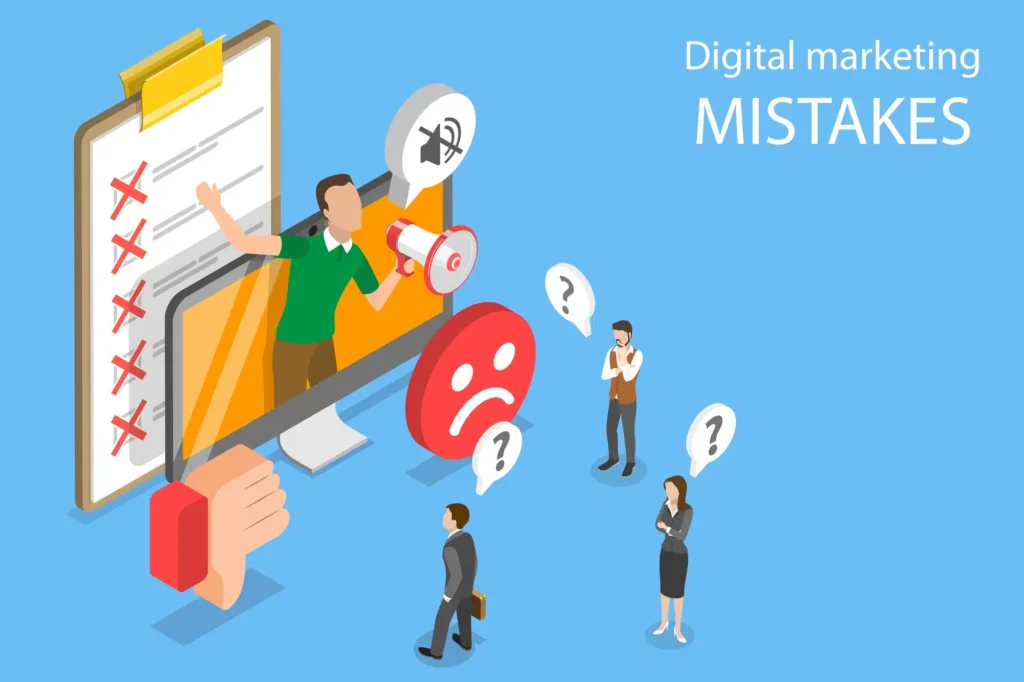
In the dynamic world of digital marketing, businesses can reap significant rewards by leveraging online platforms to reach their audience. However, the complexity of digital marketing also means there are numerous pitfalls that can hinder success. This article explores the top five mistakes to avoid in digital marketing, offering examples and insights to help you navigate this ever-evolving landscape.
Introduction
Digital marketing is a powerful tool for businesses to connect with their target audience, build brand awareness, and drive conversions. Despite its potential, many companies stumble due to common mistakes that can undermine their efforts. Understanding these pitfalls and learning how to avoid them is crucial for maximizing the effectiveness of your digital marketing strategy. Here are the top five mistakes to steer clear of.
1. Ignoring the Importance of SEO
Search Engine Optimization (SEO) is critical for ensuring your content is discoverable by your audience. Ignoring SEO can result in low visibility on search engines, significantly reducing organic traffic to your site.
Example: A small business blog consistently produced high-quality content but saw little organic traffic because they neglected keyword research and on-page SEO. By not optimizing their content for search engines, they missed out on a broader audience that was actively searching for the topics they were writing about.
Solution: Invest time in understanding SEO basics. Use tools like Google Keyword Planner or Ahrefs to identify relevant keywords, optimize your content, and ensure your website follows SEO best practices.
2. Overlooking Mobile Users
With the majority of internet traffic now coming from mobile devices, overlooking mobile optimization can be a costly mistake. A website that’s not mobile-friendly can drive potential customers away.
Example: An e-commerce site experienced high bounce rates and low conversion rates on mobile devices. The culprit was a poorly designed mobile interface that made navigation difficult and checkout cumbersome.
Solution: Ensure your website is mobile-responsive. Test your site on various devices to ensure a seamless user experience. Tools like Google’s Mobile-Friendly Test can help identify and fix issues.
3. Failing to Define a Target Audience
Trying to appeal to everyone often results in appealing to no one. Without a clearly defined target audience, your marketing efforts can become unfocused and ineffective.
Example: A clothing brand launched a broad social media campaign without a clear target audience. The result was mediocre engagement and poor ROI, as the content did not resonate with any specific group.
Solution: Develop detailed buyer personas to understand your audience’s demographics, interests, and pain points. Tailor your marketing messages and campaigns to address their specific needs and preferences.
4. Neglecting Analytics
Digital marketing without analytics is like flying blind. Without tracking and analyzing data, you can’t measure the success of your campaigns or make informed decisions.
Example: A SaaS company ran multiple digital marketing campaigns but failed to track key metrics like click-through rates, conversion rates, and ROI. As a result, they couldn’t identify which strategies were working and which needed adjustment.
Solution: Use analytics tools such as Google Analytics, HubSpot, or SEMrush to track your campaigns’ performance. Regularly review your data to identify trends, measure success, and make data-driven decisions to optimize your efforts.
5. Overemphasizing Quantity Over Quality
Producing a high volume of content is less effective if the quality is poor. Low-quality content can damage your brand’s reputation and fail to engage your audience.
Example: A tech blog focused on churning out daily articles without regard to content quality. Readers found the articles repetitive and uninformative, leading to a decline in site traffic and reader engagement.
Solution: Focus on creating high-quality, valuable content that addresses your audience’s needs and interests. It’s better to produce fewer, high-impact pieces than a large volume of mediocre content. Regularly update and improve existing content to maintain its relevance and quality.
Conclusion
Avoiding these common digital marketing mistakes can significantly enhance the effectiveness of your efforts. By prioritizing SEO, optimizing for mobile, defining your target audience, leveraging analytics, and focusing on quality content, you can create a robust digital marketing strategy that drives results. Remember, the key to success in digital marketing is continuous learning and adaptation. Stay informed about industry trends, regularly review your strategies, and be ready to pivot when necessary. By doing so, you’ll be well-equipped to navigate the complex digital landscape and achieve your marketing goals.